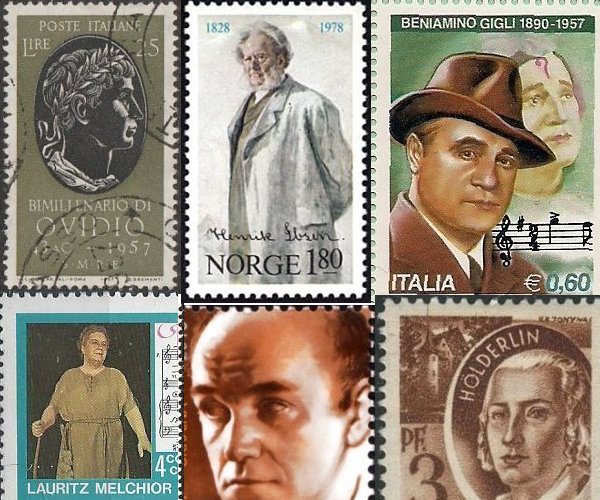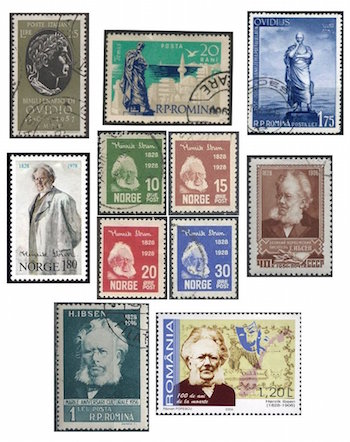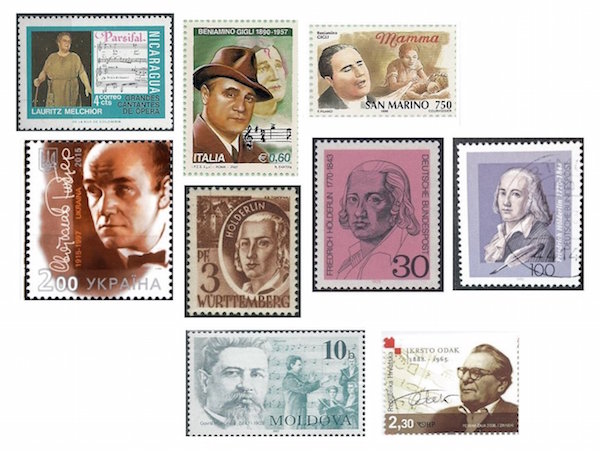The Arts on the Stamps of the World — March 20
An Arts Fuse regular feature: the arts on stamps of the world.
By Doug Briscoe

Today is the birthday of two very great writers, two very great tenors, a very great pianist, a great poet, and several other very good people.
The poet we know as Ovid (20 March 43 BC – AD 17/18) was Publius Ovidius Naso when he was at home, which, sadly, was not where he was for the last decade of his life. He was exiled from Rome by Augustus for reasons that still remain unclear. Ovid’s greatest work, the Metamorphoses, has not only supplied posterity with many details of Greco-Roman mythology but has also served as the inspiration for countless works of art in all forms. But there are many other Ovidian poems that have to some extent been overshadowed by the Metamorphoses: love poetry, the Amores, the Ars Amatoria, and the Remedia Amoris; six books of a projected series on the festivals of the months of the year, the Fasti (it’s been proposed that Ovid never finished this because in his exile he was denied access to the well-stocked libraries of Rome); and, after his deportation, the homesick writings of Tristia (“Sorrows”) and Epistulae ex Ponto (“Letters from the Black Sea”). Some of the musical works that owe their existence to Ovid include Mozart’s very early opera Apollo et Hyacinthus (1767) and Richard Strauss’s quite late opera Daphne (1938), Benjamin Britten’s solo oboe suite Six Metamorphoses after Ovid (1951), and a 1936 setting by Elliott Carter of a section from Fasti written for incidental music to a play (Mostellaria) by Plautus. The two (!) Romanian Ovid stamps showcase Ettore Ferrari’s statue of Ovid in the city of Constanța (ancient Tomis), where Ovid was exiled. (Constanța also boasts an Ovid Square, Ovidius University, and an Ovidius High School, and, by the way, Ettore Ferrari’s birthday is five days from now.)
Henrik Ibsen, too (20 March 1828 – 23 May 1906), has proved a rich source for music, in his case, of course, with his plays as well as his poetry. I’ll focus on this aspect in view of the likelihood that the average Arts Fuse reader’s familiarity with the great Norwegian’s work is already more than adequate. Besides songs by Grieg, Hugo Wolf, Alban Berg, Holst, Delius, and many others (including three great conductors, Otto Klemperer, Felix Weingartner, and Bruno Walter!), a number of operas have been written based on Ibsen’s (mostly less well known) dramas. The first was one of Ibsen’s early plays, The Feast at Solhaug of 1856, music composed by Wilhelm Stenhammar in 1893. Others include Claudia Legare (1978, based on Hedda Gabler) by the American composer Robert Ward and, just five years ago, The Lady from the Sea (2012) by Scottish composer Craig Armstrong. Peer Gynt, of course, not only served as the subject of Grieg’s beloved incidental music (and suites), but also was made into at least two operas, one by Werner Egk (1938) and another by Viggo Edén (2001), as well as providing an opportunity for more incidental music by Harald Saeverud (1948) and several others. I should add that Ibsen wrote a short opera parody in the form of a pamphlet in 1851. “Norma, or a Politician’s Love” was a political satire that used names of characters from Bellini’s opera.

Speaking of opera, two of the world’s most beloved opera singers were born on precisely the same day, March 20, 1890. Danish tenor Lauritz Melchior (d. 19 March 1973, the day before his 83rd birthday) is celebrated as one of the world’s paradigmatic Wagnerian singers. He is featured on one of a series of stamps honoring opera stars issued by Nicaragua in 1975. Beniamino Gigli (d. November 30, 1957), meanwhile, was almost exclusively a proponent of the Italian repertoire. His two stamps originate from San Marino (1996) and, of course, Italy (2007). The latter comes from a souvenir sheet that was kindly given to me by Boston area organist Leonardo Ciampa, who has recently published a book about Gigli.
2015 marked the centenary of one of the greatest pianists of the 20th century, Sviatoslav Richter (March 20 [O.S. March 7] 1915 – August 1, 1997), who, incredibly, was largely self-taught. I wasn’t aware of it at the time, but Ukraine issued a stamp in his honor on that very day (March 20, 2015). Though he played a wide repertoire, Richter’s focus was on Bach, Beethoven, Schubert, Schumann, Chopin, and Liszt, as well as on music by his contemporaries and countrymen. He gave the premieres of both the Seventh and Ninth Sonatas of Prokofiev, and the one time in his life that he took to the conductor’s podium was to direct the first performance of Prokofiev’s Symphony-Concerto.
I had no idea that the poetry of Friedrich Hölderlin (20 March 1770 – 7 June 1843) had inspired so many composers, not only “the usual suspects”—Schumann, Brahms, Richard Strauss, Pfitzner, et al.—but Britten (Hölderlin Fragments, Op. 61), René Leibowitz, Lee Hoiby, and former BSO Assistant Conductor Robert Spano (!), whose Hölderlin Songs just had their première in 2014. Hölderlin seems to have especially resonated with twentieth-century composers from German-speaking countries, and this is in part due to the fact that Hölderlin’s work was not so widely disseminated during his own lifetime, which was marked to some extent by hypochondria and seclusion, and for the remainder of the 19th century. It was only in 1913 that the first two volumes of his complete works saw publication, and then the floodgates began to open: Hindemith, Stefan Wolpe, Ernst Krenek, Max Reger and Josef Matthias Hauer, both of whom we celebrated on their birthday just yesterday (!), Henze, Viktor Ullmann (who set Hölderlin while interned at Terezin), Gideon Klein, Wolfgang Rihm, Gottfried von Einem, Karl Weigl, Hanns Eisler, Friedrich Cerha, Harald Genzmer, Wilhelm Killmayer, and Wolfgang Fortner have all written songs to Hölderlin poems. Hindemith’s Piano Sonata no. 1, “Der Main”, and Henze’s Seventh Symphony also owe their inspiration to Hölderlin. Non-Germans include Alphons Diepenbrock, Luigi Nono (Fragmente-Stille and Prometeo), György Ligeti (3 Fantasies after Hölderlin), Bruno Maderna (two works from 1964), and Kaija Saariaho.
Gavriil Musicescu and Krsto Odak were both educators as well as composers, and both were seminary students. Musicescu (1847 – December 21, 1903), almost exclusively a choral composer, taught at and eventually became director of the Conservatory of Iași. Himself a singer and choir conductor, he also collected and harmonized folksongs and is considered an important figure in the Romanian choral tradition.
Krsto Odak (1888 – November 4, 1965) studied with Vítězslav Novák in Prague and became a professor at the Academy of Music in Zagreb. Like Musicescu, he composed sacred choral music, but his output was much more diverse, including four symphonies, a piano concerto and one for saxophone, various other orchestral and chamber works, opera and incidental music, and songs.

Just yesterday we saluted American painter C.M. Russell, who was born in Missouri in 1864. Today is the birth anniversary of his artistic forebear George Caleb Bingham (March 20, 1811 – July 7, 1879), who, although born in Virginia, moved to Missouri in childhood and left many paintings of scenes along the Missouri River. Bingham was self-taught, earning money as a portrait painter before he was out of his teens and opening a successful studio in St. Louis when he was 27. He was thus able to travel to Philadelphia, New York, and Europe to pursue his desire to study the Old Masters. Besides his portraits and paintings of life on the frontier—an example of which, Boatmen on the Missouri (1846), appears on the stamp—Bingham was also active in politics, having been elected to the Missouri House of Representatives as early as 1848. He painted a series of three works on the American electoral process, The County Election (1852), Stump Speaking (1853-4), and The Verdict of the People (1854-5), and remained active in politics through his later years. Since his bicentenary six years ago, 23 newly discovered Bingham paintings have been authenticated.
Belfast-born John Lavery (20 March 1856 – 10 January 1941), friend of Whistler, was appointed an official painter during World War I and received a knighthood in 1921. His second wife, Hazel, née Martyn, an American beauty from Chicago and herself a painter, sat for her husband about 400 times. One of these pictures is seen (to disadvantage in a dim reproduction) on this Irish stamp of 1999. This particular piece, however, Lady Lavery as Cathleen ni Houlicán (1928), would certainly be very familiar to the Irish, as it was specifically painted to be used on that country’s banknotes, with Lady Lavery representing an allegorical figure of Ireland. All the same, the original is a much brighter work—much of Lavery’s work is brightly lit—than one might assume from seeing the stamp. The Laverys permitted their London home to be used for the negotiations for the Anglo-Irish Treaty in 1921, the Irish delegation being led by Michael Collins, whom Lavery painted in state after his assassination the next year.

The Estonian graphic artist Eduard Wiiralt (March 20, 1898 – January 8, 1954) was twice interrupted in his studies thanks to the grand events of history, first when he left the Tallinn Art Trade School as the Germans occupied Estonia during World War I and then as a result of the Estonian War of Independence, which caused him to abandon his apprenticeship in the Pallas Art School in Tartu. Pallas, did, however, supply him with a grant to study in Dresden in 1922-3. One can’t help supposing that his desire to avoid more turmoil led him to live in Paris between 1925 and 1939, when he returned to Tallinn just in time to experience another war and occupation. After that one, he said enough is enough, left for Sweden in 1945, and ended his days back in Paris. It was during his earlier years in that city that he created the harrowing etching Hell (1932), which is shown divided among four stamps on an Estonian souvenir sheet issued for his centenary. A larger image of it can be seen here.
Oswald George “Ozzie” Nelson (March 20, 1906 – June 3, 1975) played the sax in his youth and was a band leader and singer of some note in the 1930s. He married the band’s lead vocalist, Harriet Hilliard, in 1935. Radio beckoned, and there The Adventures of Ozzie and Harriet made its debut as early as 1944, proceeding to TV in 1952, where it aired for a further fourteen years. According to some sources Nelson was a controlling bastard who dragooned his sons David and Ricky into show business. I don’t know, but that’s what I’m hearing.
The singer who went by the stage name of Sister Rosetta Tharpe (March 20, 1915 – October 9, 1973) was hailed as “the first great recording star of gospel music” [Wikipedia]. Her birth name is uncertain, possibly Rosetta Nubin, maybe Rosether Atkins. The name Tharpe is a slight adaptation of the name of her first husband, Thomas Thorpe. One of the songs from her very first recording session, “Rock Me”, was a strong influence on later rock-and-roll performers, and it was made in 1938! That and the three other gospel songs she recorded at that time were big hits and launched her career. She was also a superb guitarist at a time when a woman seen to be playing that instrument was frowned upon. Little Richard and Johnny Cash both said she was their favorite singer in childhood. A 2011 BBC documentary, Sister Rosetta Tharpe: The Godmother of Rock & Roll, has been shown on PBS.
On this date in 1923, Pablo Picasso had his first United States showing at The Arts Club of Chicago.
A graduate of the University of Massachusetts with a B.A. in English, Doug Briscoe worked in Boston classical music radio, at WCRB, WGBH, and WBUR, for about 25 years, beginning in 1977. He has the curious distinction of having succeeded Robert J. Lurtsema twice, first as host of WGBH’s weekday morning classical music program in 1993, then as host of the weekend program when Robert J.’s health failed in 2000. Doug also wrote liner notes for several of the late Gunther Schuller’s GM Recordings releases as well as program notes for the Boston Classical Orchestra. For the past few years he’s been posting a Facebook “blog” of classical music on stamps of the world, which has now been expanded to encompass all the arts for The Arts Fuse.

Interested in certain scientists on stamps..
Ostwald SWEDEN,
Johann Friedrich Wilhelm Adolf von Baeyer SWEDEN